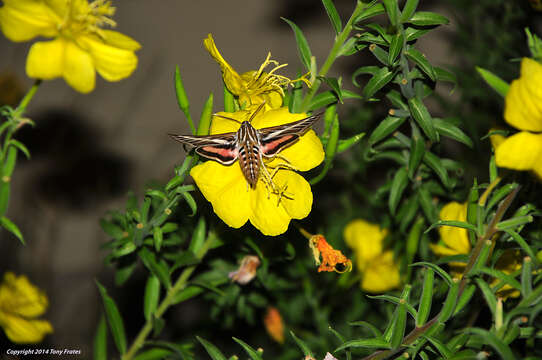Western evening-primrose and White-lined Sphinx moth

Descrição:
After first seeing one of these moths about a week ago, I have been on the lookout every night since and finally, thanks to a neighborhood cat who has claimed our yard as part of its turf and who was watching these when I came home fairly late, I had a second chance to photograph them (there were two but only one stuck around - the remaining moth did not however seem to be bothered by the camera flash; the cat on the other hand ran away very quickly!).I had a street lamp that provided some lighting behind me which definitely helped. These moths, also called "Hummingbird moths" in view of their energetic flight pattern, are in almost constant motion and do not hold still for more than a second or two.This is a large moth. The petals of this tall evening-primrose (which itself can grow to a height of 8 feet; here they are in the 5 to 6 foot tall range) are about 4 cm long so the wing span of this moth is something like 10+ cm (roughly 4 "). It is beautiful moth that is a very hard worker and clearly is an effective pollinator for this species as it systematically visits every single available flower (and they were many here) and then does it all over again. The moth is Hyles lineata and the plant is the locally native Oenothera elata var. hirsutissima. Each flower of this evening-primrose is open for only a single night.August 11, 2014, Salt Lake County, Utah, in horticulture, at about 9:15pm. Postscript: to see what the caterpillar phase of this moth looks like, see: www.flickr.com/photos/tonyfrates/48811184647/
Incluído nas seguintes páginas:
- Life
- Cellular
- Eukaryota (Eucariontes)
- Archaeplastida
- Chloroplastida
- Streptophyta
- Embryophytes
- Tracheophyta
- Spermatophytes (Spermatophyta)
- Angiosperms
- Eudicots
- Superrosids
- Rosids
- Myrtales
- Onagraceae
- Oenothera
- Oenothera elata
- Oenothera elata hirsutissima
Esta imagem não aparece em nenhuma coleção.
Informação de origem
- licença
- cc-by-nc-sa
- direitos autorais
- Tony Frates
- fotógrafo
- Tony Frates
- original
- arquivo de mídia original
- visite a fonte
- site do parceiro
- Flickr Group
- ID


